Prestack Depth Migration Imaging of Permafrost Zone with Low Seismic Signal–Noise Ratio Based on Common-Reflection-Surface (CRS) Stack
Abstract
1. Introduction
2. Common-Reflection-Surface Stacking
2.1. Principles of CRS Stacking
2.2. CRS Stacking vs. DMO Stacking
2.3. CRS Stacking vs. CMP Flexbinning
2.4. CRS Stacking vs. Prestack Noise Attenuation
3. Imaging Application
3.1. Seismic Geological Conditions of the Qiangtang Basin
- (1)
- Well-preserved Upper Triassic–Lower Jurassic source rocks;
- (2)
- Composite structural traps (thrust-related anticlines and stratigraphic pinch-outs);
- (3)
- Favorable reservoir-seal assemblages in Middle Jurassic carbonates.
- (1)
- Suboptimal acquisition parameters: Rugged topography (>1000 m relief) and permafrost-induced velocity anomalies compromise data integrity (S/N ratio < 2:1 across 40% of the study area).
- (2)
- Inadequate velocity modeling: LVZ heterogeneity introduces ~15% time-depth conversion errors, reducing trap delineation accuracy.
- (3)
- Ambiguous seismic interpretation: Limited bandwidth (8–35 Hz) and complex multiples yield > 30% uncertainty in reservoir thickness estimates.
- (1)
- A quantitative evaluation of CRS stacking efficacy versus conventional workflows;
- (2)
- Systematic aperture parameterization for optimal SNR enhancement;
- (3)
- Kinematic validation via diffraction focusing analysis.
3.2. Application of CRS Stacking and Method Comparison
- Near-surface velocity = 2500 m/s
- Maximum dip = 45°
- Offset regularization = 60–7180 m (80 m interval)
- (1)
- Shallow Layers: The CRS-stacked spectra show tightly focused energy clusters with laterally continuous velocity trends. At CMP 1750 (Figure 6b, lower third panel), the shallow cluster shifts to higher velocities, correlating with steep structural features near CMP 1150 evident in the stacked profile (Figure 7b). This velocity increase, consistent with structural dip effects, demonstrates an improved SNR via CRS stacking.
- (2)
- Deep Layers: SNR enhancement is evidenced by tighter energy clustering (red arrows marked, Figure 6b), especially at the maximum offset (7180 m), where stacking velocities remain below 5500 m/s. The velocity distribution indicates a generally increasing subsurface velocity gradient in the Tonamu area, with no significant reversals except in shallow permafrost zones. Reliable deep reflections within structural depressions are also identified.
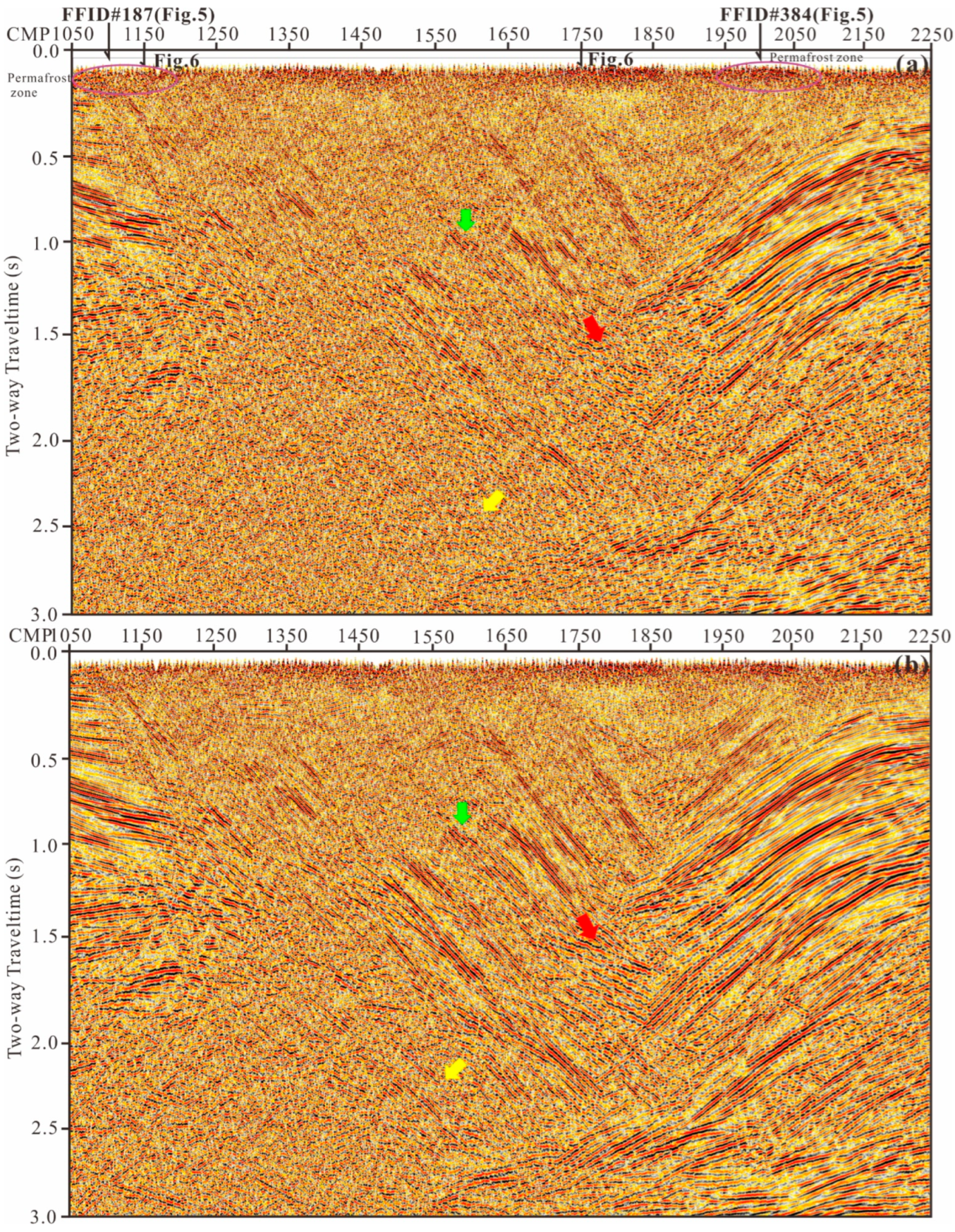
- (1)
- Preprocessed: A low SNR within shallow, steeply dipping structures and ambiguous deep fracture geometries below 2.0 s TWT.
- (2)
- CRS stacking: Enhanced continuity beneath permafrost zones, improved delineation of thin-bedded sandstone–mudstone/limestone interbeds, and stronger diffraction energy.
- (1)
- The CMP stacking profile (Figure 8a) shows general SNR improvement in shallow steep-structure zones, yet deep-layer enhancing is limited.
- (2)
- PreRNA processing (Figure 8b) exhibits a moderate deep-layer SNR and cleaner stratigraphic resolution relative to semblance smoothing, revealing distinct wave impedance features.
- (3)
- DMO Stacking enhances steeply dipping structures, oblique reflections, and diffraction tails, yielding improved section clarity (Figure 8c).
- (4)
- CRS Stacking shows a significant SNR across both shallow and deep intervals relative to the other methods (Figure 8d), confirming its technical superiority for processing low-SNR data within permafrost environments.
3.3. Comparison of CRS Stacking Migration Imaging
- (1)
- PSTM velocity modeling: The RMS velocity field, derived from CRS-stacked velocity analysis, was converted into interval velocities using the Dix (1955) formula. This initial interval velocity model was iteratively refined through the careful flattening of CRP gathers, a step crucial for mitigating velocity errors induced by complex overburden effects and improving lateral velocity resolution.
- (2)
- PSDM velocity model calibration: The smoothed, time-domain interval velocity model was subsequently depth-converted to generate an initial depth velocity volume. This depth model was then rigorously calibrated using near-surface well-defined QZ3 and the subsurface flattening of common-depth-point (CDP) gathers, and structural constraints to yield the final, geologically consistent PSDM velocity model used for imaging.
- (1)
- Position ④ (Deep LSSZ): The time-domain PostSM/PSTM profiles show horizontal interfaces where diffraction apexes indicate lateral fractures, while the depth-domain profiles reveal complex folding structures (Figure 9a,b). These features correspond to the LSSZ (Zhang et al., 2011) [12], interpreted as a tectonic response to paleo-ocean closure.
- (2)
- Position ① (Edged LSSZ): CRS stacking effectively preserves subtle, yet coherent, diffraction energy generated by complex rugosity at the edges of a deep structural depression. Kirchhoff PSDM successfully focuses this energy, yielding a well-defined image of the depression geometry, including its steeply dipping flanks and potential internal structural heterogeneities (Figure 8c,d).
- (3)
- Positions ②–③ (Shallow LSSZ): Within zones exhibiting significant structural complexity and steep dips, a critical observation is that both PSTM and PSDM, when applied to the CRS-optimized prestack gathers, maintained SNR levels comparable to the inherently smoother PostSM results. This demonstrates that the primary benefit of prestack migration in such contexts lies not merely in SNR enhancement—effectively achieved by the CRS stacking preconditioning—but in the significantly improved time/depth-domain velocity models.
4. Discussion
- (1)
- Fresnel Zone Aperture: Spatiotemporal aperture scaling (40 m at 0 s → 800 m at 4.0 s) dictates shallow-to-deep event coherency. Suboptimal values distort wavefront kinematics on inclined/curved interfaces, inducing the erroneous migration repositioning of diffraction apexes (Figure 7b and Figure 8d) and ambiguous fault-plane imaging—particularly problematic for fracture characterization in carbonates.
- (2)
- Maximum Structural Dip (45°): This dip constraint controls steep/reverse fault imaging. Time-domain migrations (Figure 9b,d) exhibit coherent event crossovers along deep depression margins, attributable to either 2D surface-wave mode contamination or excessive operator aperture. Depth-domain migration employing CRS-derived velocities effectively attenuates these artifacts, confirming that CRS gathers enhance both kinematic accuracy and amplitude fidelity during wavefield reconstruction.
- (3)
- Offset Regularization (60–7180 m, 80 m intervals): Angle-dependent parameter scanning requires the iterative calibration of mute functions and time-gate parameters to optimize AVA compliance, necessitating empirical testing for amplitude-preserving applications (e.g., AVO inversion).
- (1)
- The hyperbolic traveltime assumption underlying CRS processing becomes unstable when the SNR falls below 5 dB. In such cases, automated data-driven parameter optimization (e.g., aperture selection) may converge toward noise-dominated solutions, particularly where ambient seismic interference exceeds −10 dB relative to primary amplitudes. This necessitates conservative aperture constraints and iterative geophysical QC (many crossing events are shown in Figure 8d).
- (2)
- CRS kinematics presume isotropic wave propagation, rendering it suboptimal for strongly anisotropic sequences (e.g., shale-dominated thrust belts with Thomsen parameters ε > 0.3). Many big dip-angles in the deep strata (Figure 10b,c) reveal lateral variation in the first Fresnel zone aperture in our study area’s ice-rich permafrost zones, attributable to unaccounted VTI effects. Such limitations compound in complex overburdens exhibiting azimuthal anisotropy.
- (1)
- Multi-geophysical integration: The joint inversion of seismic CRS attributes with electromagnetic (EM) and aeromagnetic datasets to resolve suture-zone geometry and basement involvement, particularly through the co-rendering of CRS-derived structural fabrics with magnetotelluric (MT) resistivity sections.
- (2)
- Algorithmic advancement: The development of dip-adaptive aperture schemes balancing diffraction preservation and migration-noise suppression using local wavefield curvature constraints, with explicit testing on 3D field datasets from permafrost-affected zones or petroliferous basins to evaluate scalability.
- (3)
- Physical-property inversion: The integration of CRS kinematic attributes as regularization constraints for full-waveform inversion (FWI) to refine data-driven velocity models in permafrost-affected zones and implement RTM imaging, leveraging the signal enhancement from CRS supergathers.
- (4)
- High-performance computing: The implementation of GPU-accelerated CRS kernels, enabling real-time QC for large 3D surveys and small offset intervals, while addressing memory bottlenecks through domain decomposition strategies.
5. Conclusions
- CRS stacking surpasses legacy processing (CMP FlexBinning, DMO stacking, PreRNA) in improving SNRs across shallow-to-deep intervals. By optimizing Fresnel zone radii and structural dip constraints (≤45°), it enhances reflection continuity while preserving the diffraction signatures essential for fault-zone characterization.
- The method delivers more accurate stacking velocities and preserves critical diffraction energy adjacent to fault planes, providing robust velocity constraints for PSDM model building.
- Regularized CMP/shot gathers from CRS processing facilitate high-fidelity PSDM and migration velocity analysis (MVA), markedly improving structural resolution and event coherency in migrated profiles.
Author Contributions
Funding
Data Availability Statement
Acknowledgments
Conflicts of Interest
References
- Wu, Z.; Gao, R.; Lu, Z.; Ye, P.; Lu, L.; Yin, C. Structures of the Qiangtang Basin and their significance to oil-gas exploration. Acta Geol. Sin. 2014, 88, 1130–1144. [Google Scholar]
- Wu, Z.; Ji, C.; Zhao, Z.; Yang, Y. Main source rock and oil resource potential of the Bandaohu-Donghu area in the northern Qiangtang Basin. Acta Geol. Sin. 2019, 93, 1738–1753. [Google Scholar]
- Wang, J.; Wang, Z.; Fu, X.; Song, C.; Tan, F.; Wei, H. New discoveries from the first petroleum scientific drilling (QK-1) in the Qiangtang Basin, Tibetan Plateau. Chin. Sci. Bull. 2022, 67, 321–328. [Google Scholar] [CrossRef]
- Anees, A.; Zhong, S.W.; Ashraf, U.; Abbas, A. Development of a Computer Program for Zoeppritz Energy Partition Equations and Their Various Approximations to Affirm Presence of Hydrocarbon in Missakeswal Area. Geosciences 2017, 7, 55–67. [Google Scholar]
- Li, Z.; Wei, H.; Ma, L.; Ye, T. Vibroseis acquisition tests in the Qiangtang Basin. Oil Geophys. Prospect. 2017, 52, 199–208. (In Chinese) [Google Scholar]
- Liu, Z.; Feng, H.; Lu, Y.; Gao, Y.; Zhou, L. An integrated long-wavelength statics method applied to seismic processing of Tibetan permafrost. Near Surf. Geophys. 2022, 20, 147–159. [Google Scholar] [CrossRef]
- Zhang, H.; Liu, Z.; He, R.; Li, Q. Near-surface shear wave velocity structure inversion using multi-order surface wave dispersion curves constructed from deep seismic reflection data: A case study across the Bangong-Nujiang suture zone. Chin. J. Geophys. 2020, 63, 4410–4430. (In Chinese) [Google Scholar]
- Qin, T.; Duan, Y.; Zhao, Y. Application of attribute parameters of common reflection surface (CRS) stack wave field. Oil Geophys. Prospect. 2006, 41, 530–533. (In Chinese) [Google Scholar]
- Markus, V.S.; Alexander, G. Imaging walkway VSP data using the common-reflection-surface stack. Lead. Edge 2007, 26, 764–768. [Google Scholar]
- Mikyung, Y.; Mikhail, B.; Stefen, D.; Brink, H.-J.; Gajewski, D. New insight into the crustal structure of the North German Basin from reprocessing of seismic reflection data using the common reflection surface stack. Int. J. Earth Sci. 2007, 97, 887–898. [Google Scholar] [CrossRef]
- Mikyung, Y.; Mikhail, B.; Stefen, D.; Brink, H.-J.; Gajewski, D. Reprocessing of deep seismic reflection data from the North German Basin with the common reflection surface stack. Tectonophysics 2009, 472, 273–283. [Google Scholar] [CrossRef]
- Zhang, J.; Chen, B.; Wang, X.; Liu, J.; Yang, X. Application research of common reflection surface stack based on equal traveltime surface. Oil Geophys. Prospect. 2011, 46, 881–889. (In Chinese) [Google Scholar]
- German, G.; Paul, L.S.; Liacir, S.L.; João, C.C. Part I—CRS stack: Global optimization of the 2D CRS attributes. J. Appl. Geophys. 2012, 85, 92–101. [Google Scholar]
- German, G.; Paul, L.S.; Carlos, A.F.; João, C.C. Part II—CRS-beam PSDM: Kirchhoff-beam prestack depth migration using the 2D CRS stacking operator. J. Appl. Geophys. 2012, 85, 102–110. [Google Scholar]
- Li, Z.; Sun, X.; Liu, H. Common reflection surface stack for rugged surface topography. Chin. J. Geophys. 2006, 49, 1794–1801. (In Chinese) [Google Scholar] [CrossRef]
- Endrias, G.A.; Leiv, J.G.; Martin, T. Higher-resolution determination of zero-offset common-reflection-surface stack parameters. Int. J. Geophys. 2011, 2011, 1–10. [Google Scholar]
- Hubral, P. Computing true amplitude reflections in a laterally inhomogeneous earth. Geophysics 1983, 48, 1052–1062. [Google Scholar] [CrossRef]
- Jäger, R.; Mann, J.; Höcht, G.; Hubral, P. Common-reflection-surface stack: Image and attributes. Geophysics 2001, 66, 97–109. [Google Scholar] [CrossRef]
- Elive, M.; Dirk, G.; Christian, H. Imaging of complex basin structures with the common reflection surface (CRS) stack method. Geophys. J. Int. 2004, 157, 1206–1216. [Google Scholar] [CrossRef]
- Garabito, G.; Oliva, P.C.; Ribeiro, C.C. Numerical analysis of the finite-offset common-reflection-surface traveltime approximations. J. Appl. Geophys. 2011, 74, 89–99. [Google Scholar] [CrossRef]
- Ni, Y.; Yang, K. 3D common reflection surface stack algorithm-based GPU with the output imaging scheme (3D-CRS-OIS). Oil Geophys. Prospect. 2013, 48, 49–57. (In Chinese) [Google Scholar]
- Wang, Z.; Yang, K.; Dong, S. Dip discrimination reduction with CRS-OIS. Oil Geophys. Prospect. 2015, 50, 839–847. (In Chinese) [Google Scholar]
- Sergius, D.; Dirk, G. Common-reflection-surface-based workflow for diffraction imaging. Geophysics 2011, 76, S187–S195. [Google Scholar]
- Birgin, E.G.; Biloti, R.; Tygel, M.; Santos, L.T. Restricted optimization: A clue to a fast and accurate implementation of the common reflection surface stack method. J. Appl. Geophys. 1999, 42, 143–155. [Google Scholar] [CrossRef]
- Li, Z.; Yao, Y.; Ma, Z.; Wang, H. Common reflection surface stack method based on multi-level optimization of parameters and its application. Oil Geophys. Prospect. 2003, 38, 156–161. (In Chinese) [Google Scholar]
- Sun, X.; Jia, Y.; Li, Z. Common reflection surface stack based on parameter searching by PSO. Oil Geophys. Prospect. 2019, 54, 782–786. (In Chinese) [Google Scholar]
- Eric, D.B. Normal moveout revisited: Inhomogeneous media and curved interfaces. Geophysics 1988, 53, 143–157. [Google Scholar] [CrossRef]
- Bashir, Y.; bin Waheed, U.; Ali, S.H.; Karaman, A.; İmren, C. Enhanced wave modeling & optimal plane-wave destruction (OPWD) method for diffraction separation and imaging. Comput. Geosci. 2024, 187, 105576. [Google Scholar] [CrossRef]
- Mikhail, B.; Dirk, G. Prestack seismic data enhancement with partial common-reflection-surface (CRS) stack. Geophysics 2008, 74, V49–V58. [Google Scholar]
- Schwarz, B.; Vanelle, C.; Gajewski, D.; Kashtan, B. Curvatures and inhomogeneities: An improved common-reflection-surface approach. Geophysics 2014, 79, S231–S240. [Google Scholar] [CrossRef]
- Yang, W.; Wang, R.; Wu, J.; Chen, Y.; Gan, S.; Zhong, W. An efficient and effective common reflection surface stacking approach using local similarity and plane-wave flattening. J. Appl. Geophys. 2015, 117, 67–72. [Google Scholar] [CrossRef]
- Marcin, P.; Klaus, B.; Manfred, S.; Wieslaw, B. Improved 3D seismic attribute mapping by CRS stacking instead of NMO stacking: Application to a geothermal reservoir in the Polish Basin. J. Appl. Geophys. 2014, 103, 186–198. [Google Scholar] [CrossRef]
- Juergen, P.; Sven, F.; Rodolfo, B.; Alfredo, C.; Gerardo, C. CRS-based depth model building and imaging of 3D seismic data from the Gulf of Mexico coast. Geophysics 2008, 73, VE303–VE311. [Google Scholar] [CrossRef]
- Leiv, J.G.; Martin, T. Migration-velocity building in time and depth from 3D(2D) common-reflection-surface (CRS) stacking: Theoretical framework. Stud. Geophys. Geod. 2014, 59, 253–282. [Google Scholar]
- Dai, J.; Yang, Y.; Li, Z. 3D seismic data multi-survey merging processing and key techniques with the GRISYS processing system. Oil Geophys. Prospect. 2009, 44, 52–56. (In Chinese) [Google Scholar]
- Bergler, S.; Hubral, P.; Marchetti, P.; Cristini, A.; Cardone, G. 3D common-reflection-surface stack and kinematic wavefield attributes. Lead. Edge 2002, 21, 1010–1015. [Google Scholar] [CrossRef]
- Gerald, E.K.; Juergen, P.; Guido, G.; Henning, T. Noise reduction in 2D and 3D seismic imaging by the CRS method. Lead. Edge 2008, 27, 258–265. [Google Scholar] [CrossRef]
- Ashraf, U.; Zhang, H.; Anees, A.; Zhang, X.; Duan, L. Assessment of lake-level variations to decipher geological controlling factors and depositional architecture of Lake Fuxian, Yunnan Plateau: Preliminary insights from geophysical data. Geomech. Geophys. Geoenerg. Georesour. 2024, 10, 1–26. [Google Scholar] [CrossRef]
- Ali, M.; Changxingyue, H.; Wei, N.; Jiang, R.; Zhu, P.; Hao, Z.; Hussain, W.; Ashraf, U. Optimizing seismic-based reservoir property prediction: A synthetic data-driven approach using convolutional neural networks and transfer learning with real data integration. Artif. Intell. Rev. 2025, 58, 1–27. [Google Scholar] [CrossRef]
- Mikhail, B.; Stefan, D.; Dirk, G. From time to depth with CRS attributes. Geophysics 2011, 76, S151–S155. [Google Scholar] [CrossRef]
- Xiong, S.; Zhou, D.; Cao, B.; Zhao, R.; Wei, Y.; Hu, Y.; Xiao, M.; Duan, H.; Hu, X.; Zheng, Y. Characteristics of the central uplift zone in the Qiangtang Basin and its tectonic implications: Evidence from airborne gravity and magnetic data. Chin. J. Geophys. 2020, 63, 3491–3504. (In Chinese) [Google Scholar]
- Rodrigo, B.; Tiago, A.C.; Jorge, H.F.; Tygel, M. Common-reflection-surface method in weakly anisotropic vertical transverse isotropic media. Geophysics 2018, 83, C99–C113. [Google Scholar]

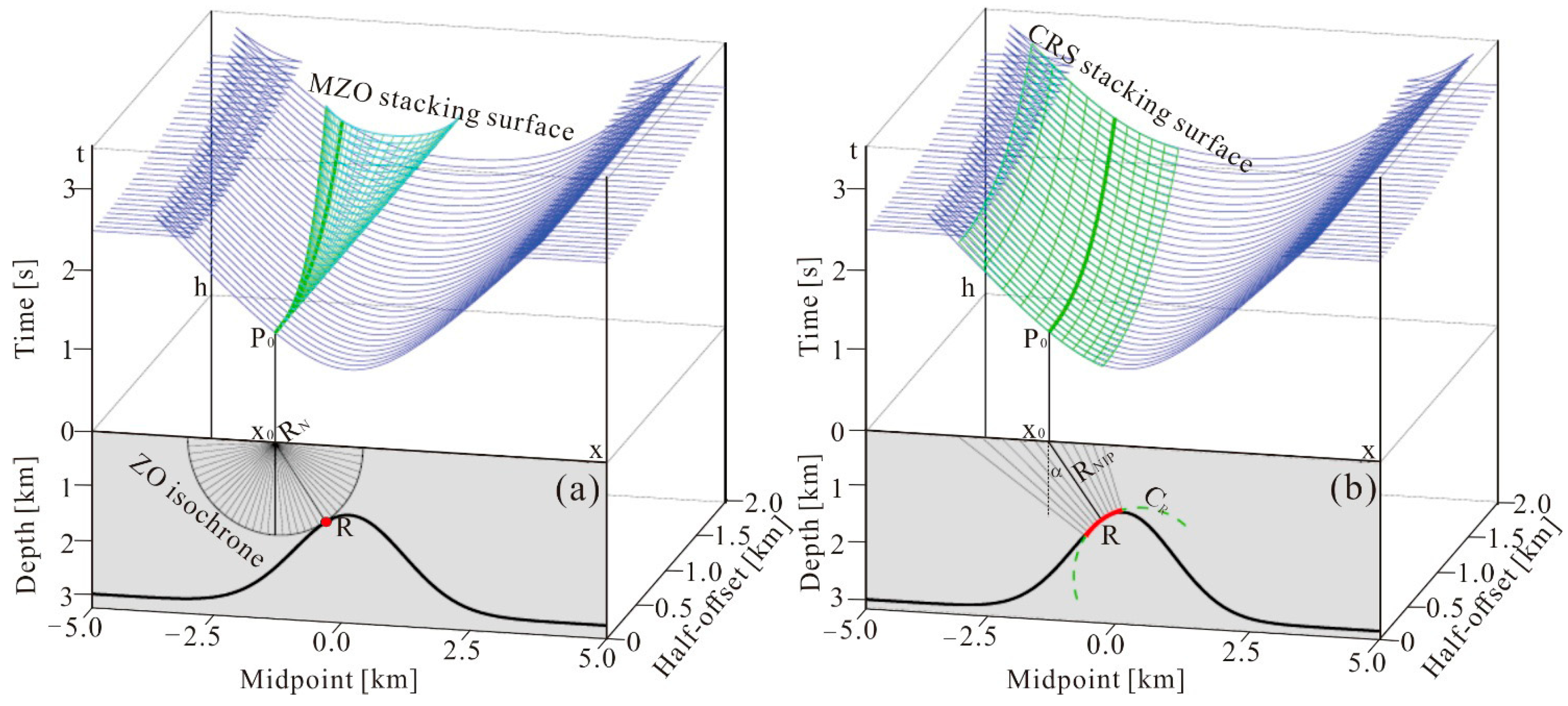
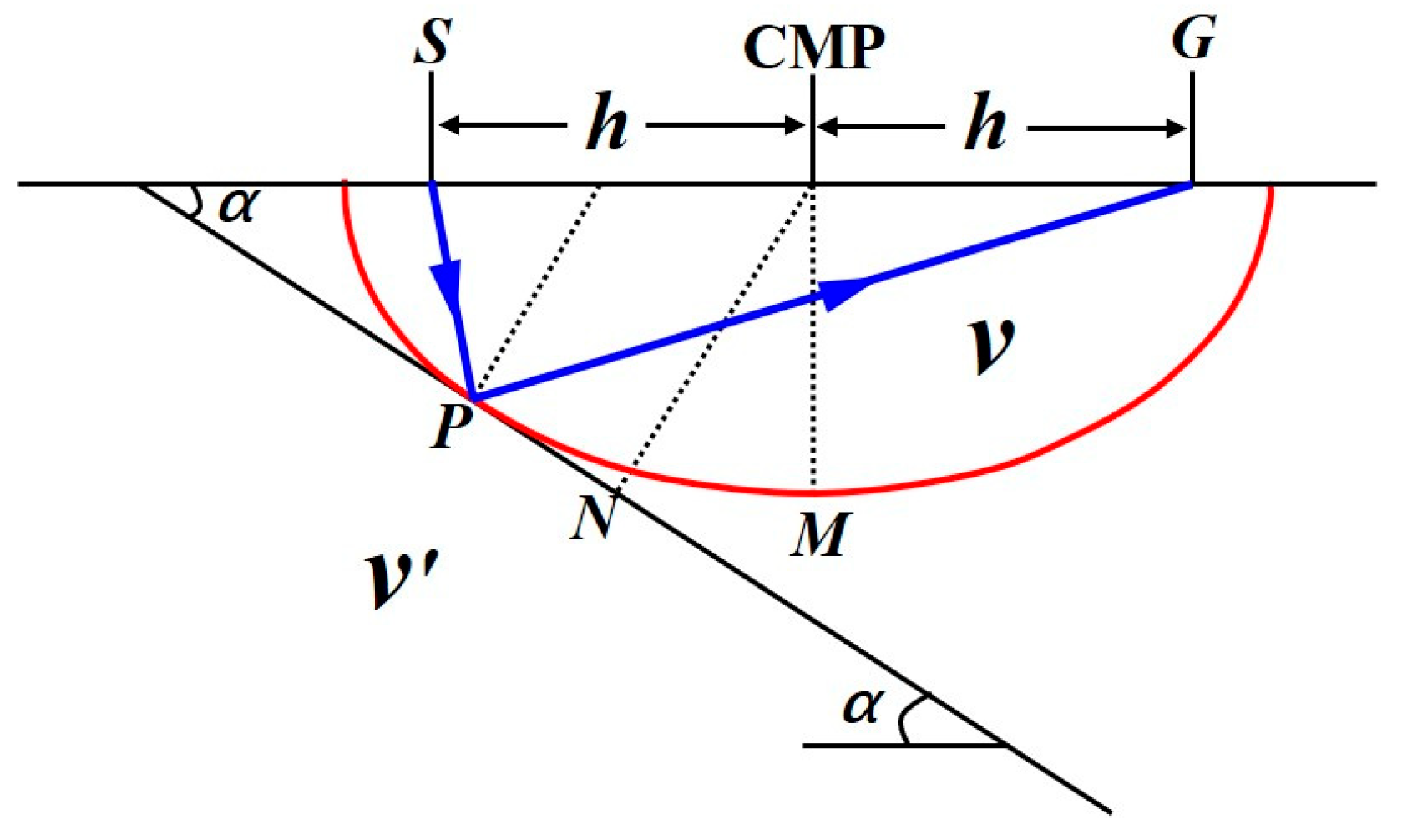
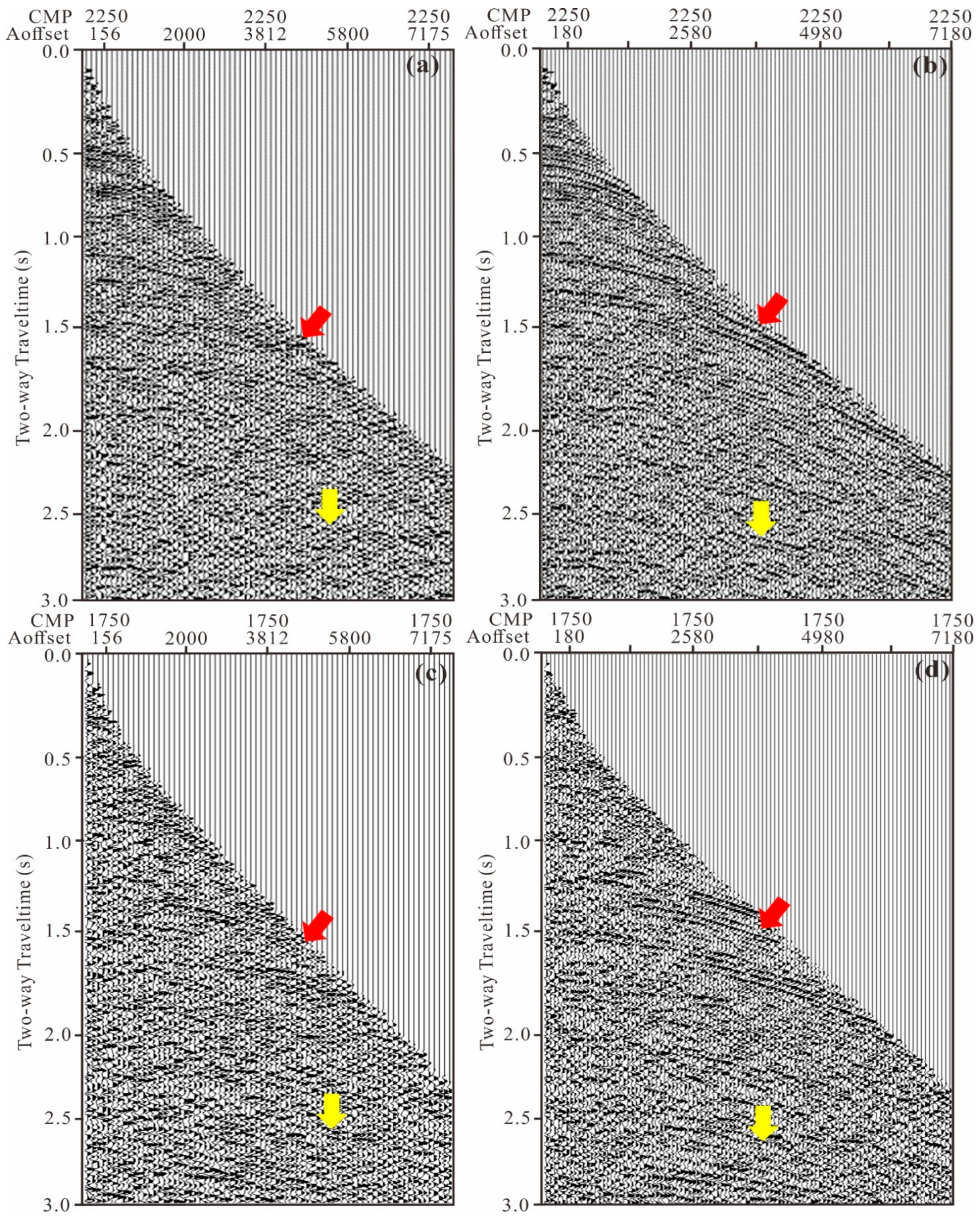
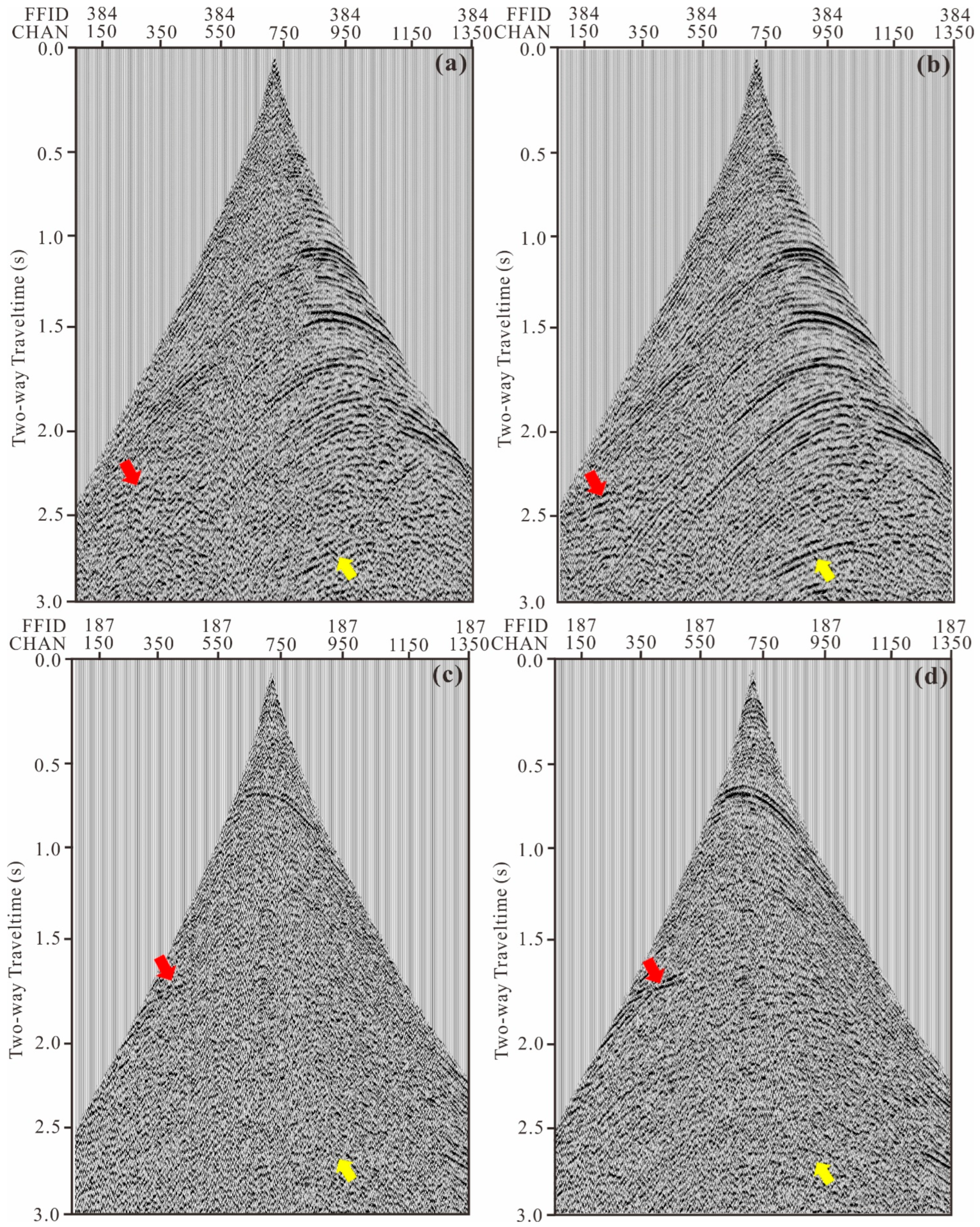
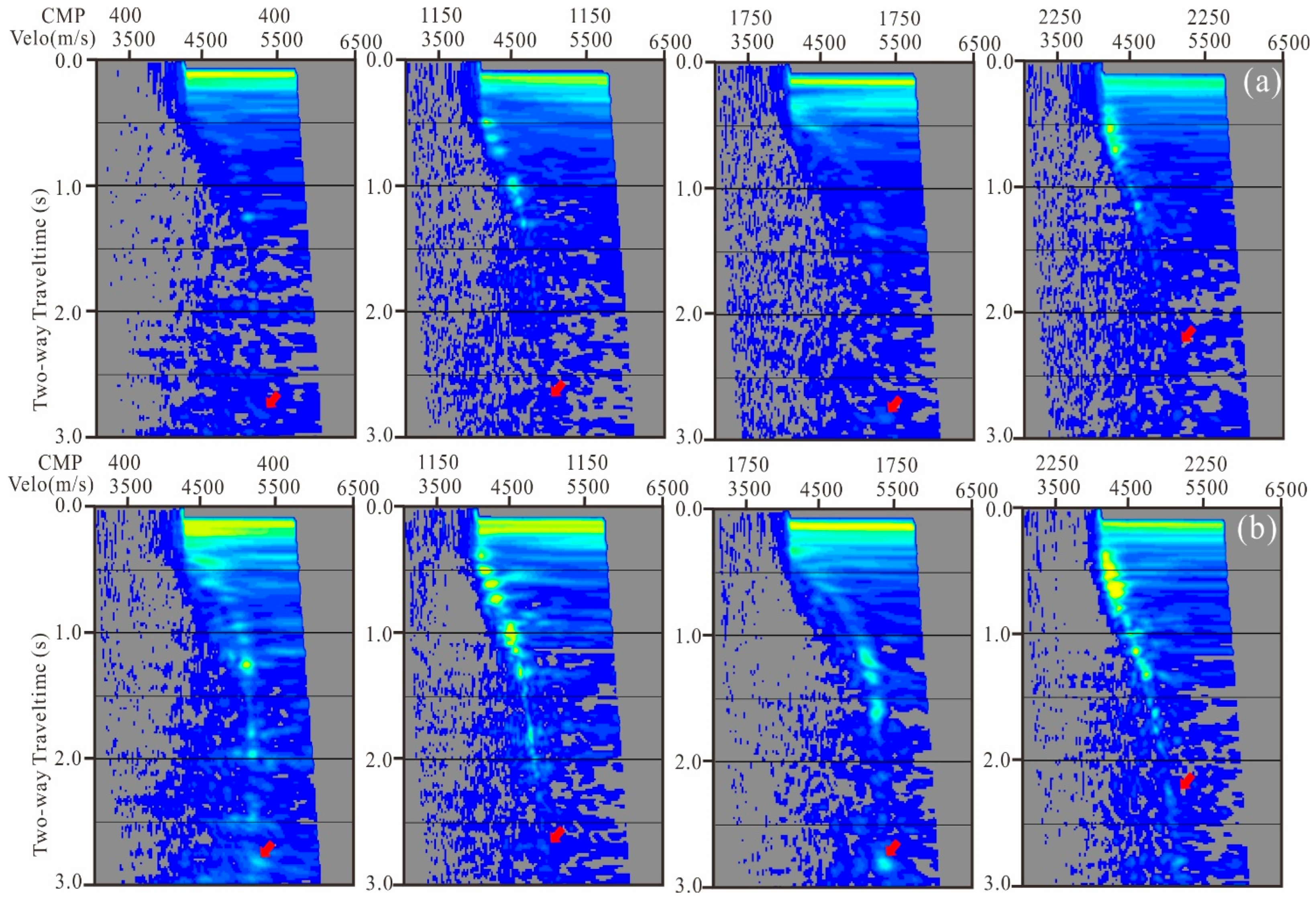
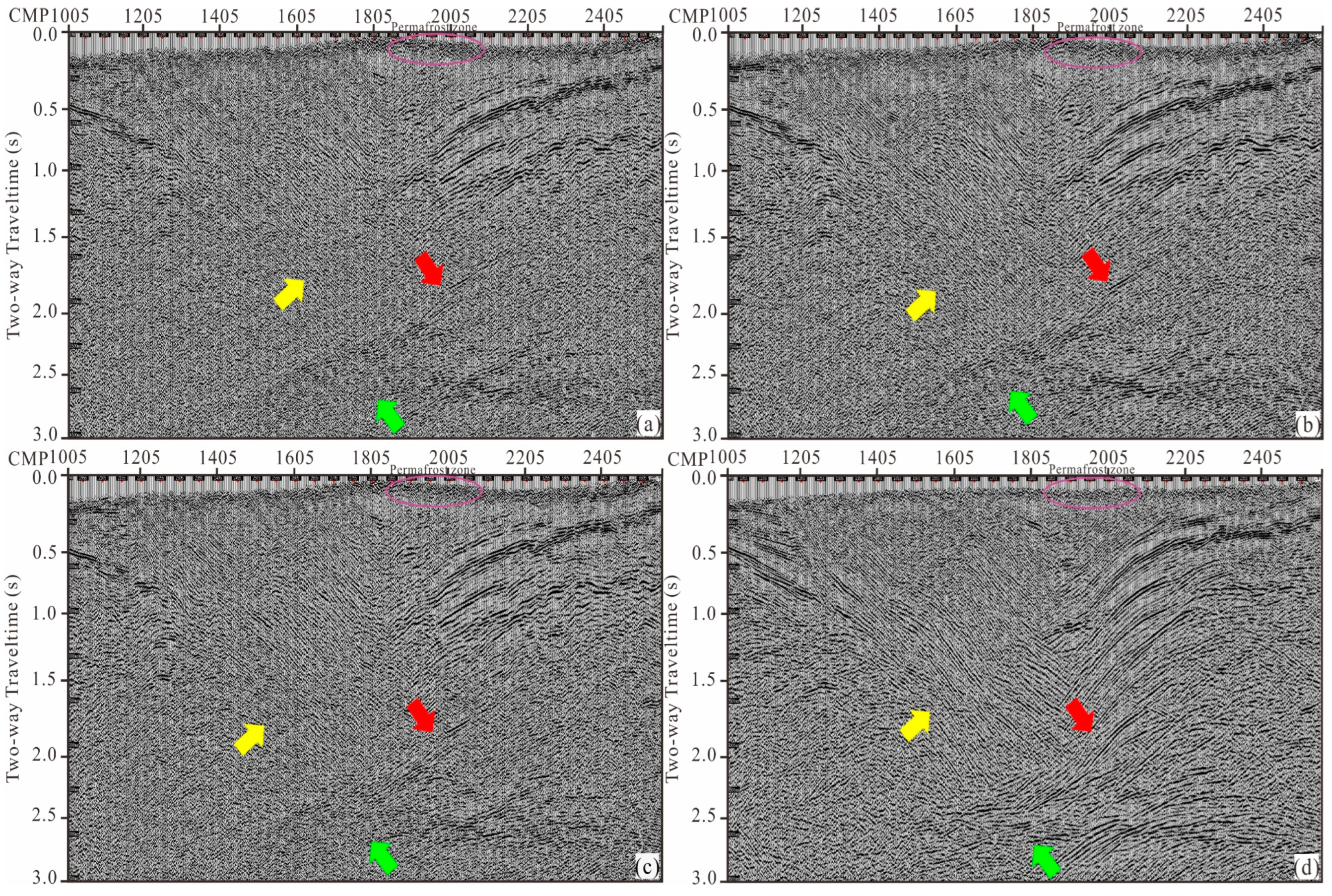
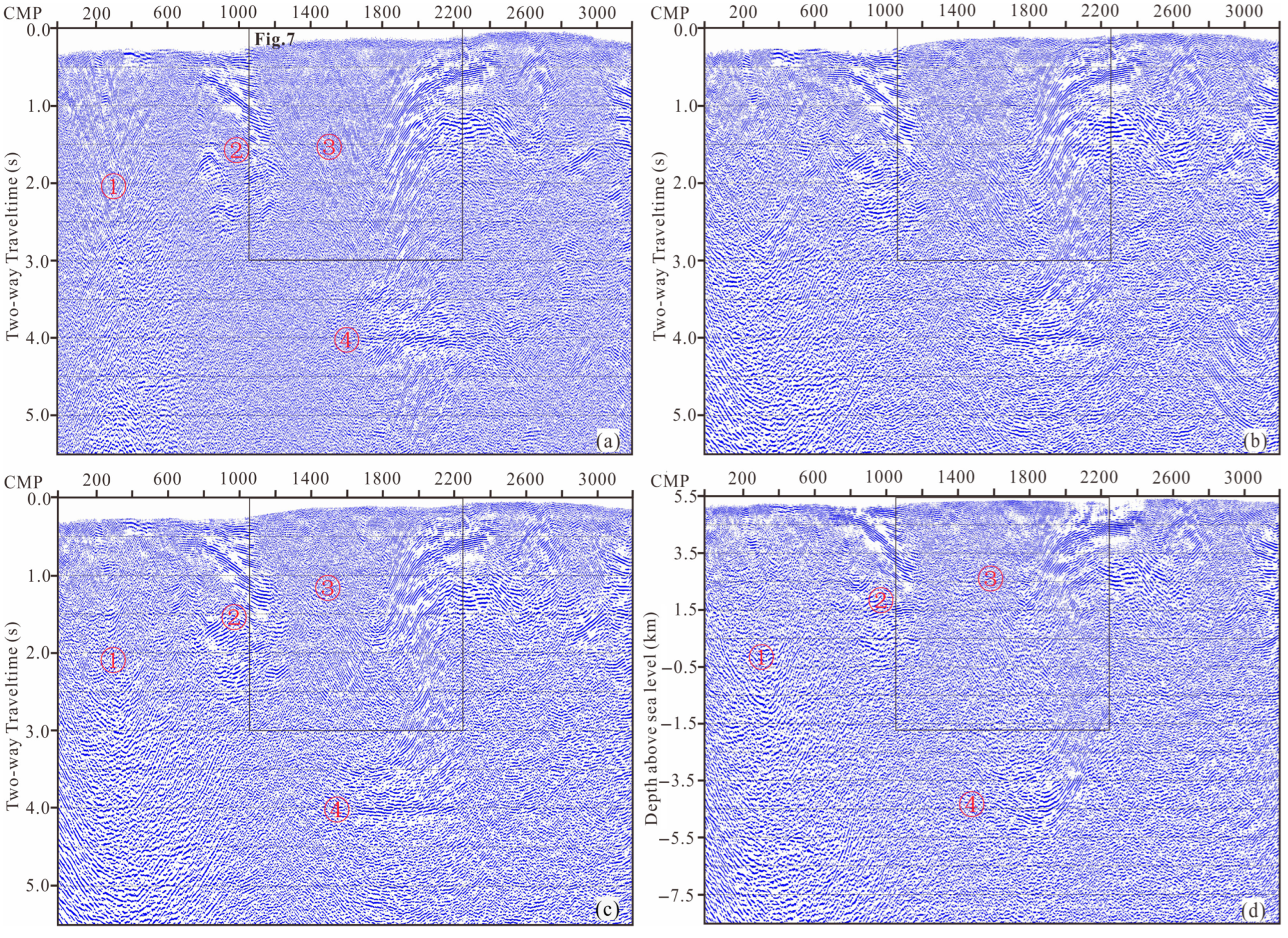
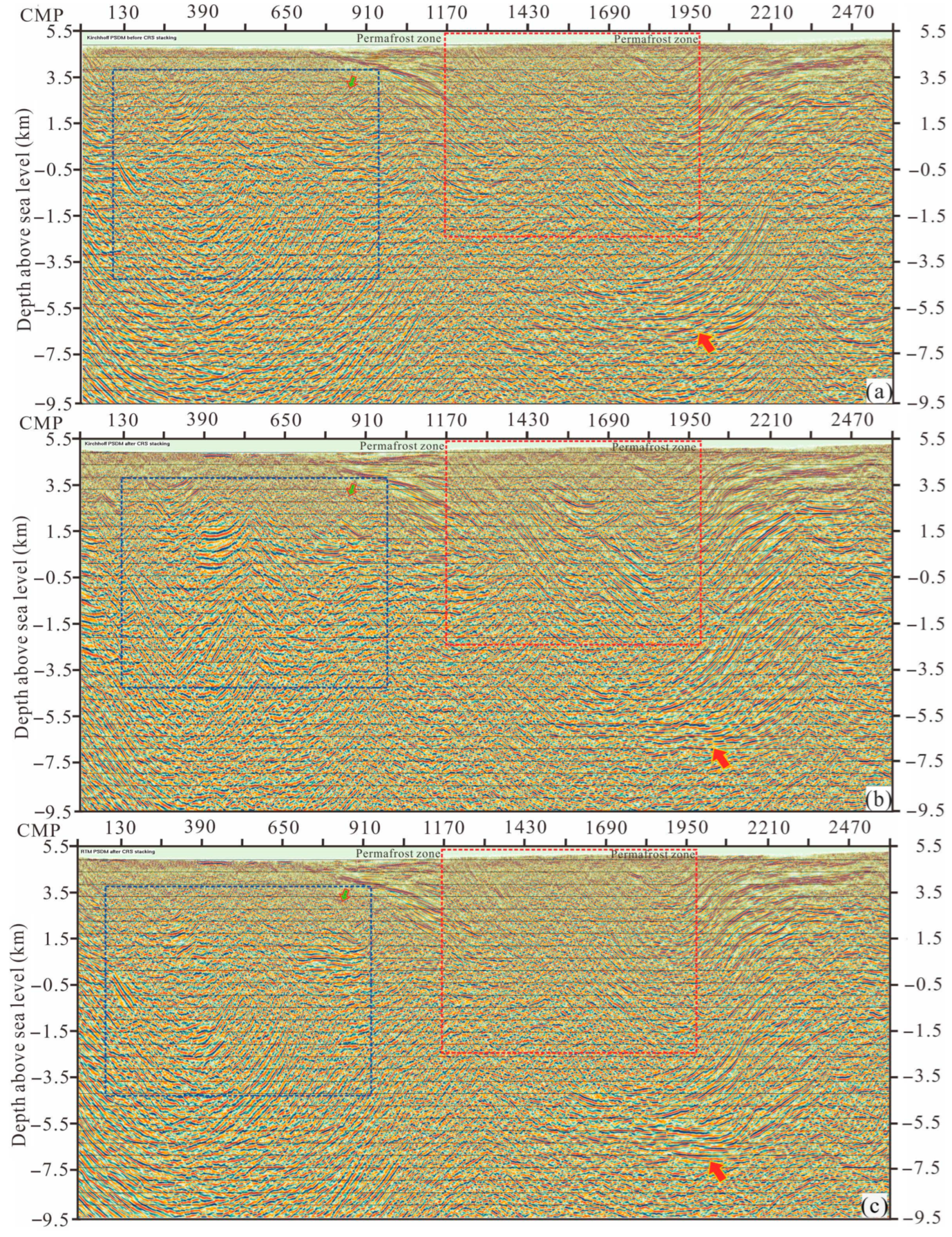
| Serial No. | Seismic Processing Methods | Key Parameters | Serial No. | Seismic Processing Methods | Key Parameters |
|---|---|---|---|---|---|
| 1 | Segy/Segd data input | None | 12 | RMS velocity analysis | DMO processing partly eliminating effects of inclined strata |
| 2 | Definition of observing systems from SPS file | Smoothing radii: 500 m | 13 | Poststack time migration | One-way wave equation migration |
| 3 | Field + tomographic statics decomposition and application | Extracting long/middle/short-wavelength components | 14 | RMS velocity QC | Checking for convergence of diffractions |
| 4 | Abnormal frequency/amplitude removal | 50 Hz industrial noise, DC voltages | 15 | Converting RMS velocity to time-domain interval velocity | Dix equation, velocity smoothing radii: 51 CRPs and 100 ms |
| 5 | Ground-roll wave suppression | Velocity: 300–1200 m/s, frequency bandwidth: 2–15 Hz | 16 | Curved-ray Kirchhoff PSTM | Iterative processing, migration aperture: 12,000 m, anti-aliasing factor: 0.6–0.7 |
| 6 | Spherical compensation | Compensating factor: 1.5 | 17 | Time-domain interval velocity QC by CRP flattening | |
| 7 | Surface-consistent amplitude composition | Balance amplitude value: 5000 | 18 | Converting interval velocity to depth-domain interval velocity | Dix equation, velocity smoothing radii: 51 CRPs and 100 ms |
| 8 | Surface-consistent deconvolution | Operator length: 240 ms, prediction distance: 16/32 ms, white noise: 0.01 | 19 | Wavefront reconstruction Kirchhoff PSDM | Iterative processing, migration aperture: 12,000 m, anti-aliasing factor: 0.6–0.7 |
| 9 | NMO velocity analysis and residual statics on reflections | Iterative processing, analysis interval: <400 m, maximum Correlation on reflections, equal-weight stacking | 20 | Depth-domain interval velocity QC by CRP flattening | |
| 10 | CMP stacking | 21 | CRP stacking | Equal-weight stacking | |
| 11 | Prestack RNA | Selecting SNR-optimal processing based on shot, CMP gathers | 22 | Automatic gain control and bandwidth-limited filtering | Control window: 750 m, bandpass filtering |
| Line Number | Acquisition Time | Observation Pattern (m) | Shots Interval (m) | Shot Factor | Geophone |
|---|---|---|---|---|---|
| TS2008_SN## | In 2008 | 7180-40-20-40-7180 | 80/160 | Explosives (12–18 kg) | DX-10 Hz |
| Acquisition Instrument | Sampling Rate/Length | Statics Datum | Replacing Velocity | CMP Interval | |
| Sercel 408X | 4 ms/8 s | 5500 m | 3500 m/s | 20 m |
Disclaimer/Publisher’s Note: The statements, opinions and data contained in all publications are solely those of the individual author(s) and contributor(s) and not of MDPI and/or the editor(s). MDPI and/or the editor(s) disclaim responsibility for any injury to people or property resulting from any ideas, methods, instructions or products referred to in the content. |
© 2025 by the authors. Licensee MDPI, Basel, Switzerland. This article is an open access article distributed under the terms and conditions of the Creative Commons Attribution (CC BY) license (https://creativecommons.org/licenses/by/4.0/).
Share and Cite
Liu, R.; Liu, Z.; Wen, X.; Zhao, Z. Prestack Depth Migration Imaging of Permafrost Zone with Low Seismic Signal–Noise Ratio Based on Common-Reflection-Surface (CRS) Stack. Geosciences 2025, 15, 276. https://doi.org/10.3390/geosciences15080276
Liu R, Liu Z, Wen X, Zhao Z. Prestack Depth Migration Imaging of Permafrost Zone with Low Seismic Signal–Noise Ratio Based on Common-Reflection-Surface (CRS) Stack. Geosciences. 2025; 15(8):276. https://doi.org/10.3390/geosciences15080276
Chicago/Turabian StyleLiu, Ruiqi, Zhiwei Liu, Xiaogang Wen, and Zhen Zhao. 2025. "Prestack Depth Migration Imaging of Permafrost Zone with Low Seismic Signal–Noise Ratio Based on Common-Reflection-Surface (CRS) Stack" Geosciences 15, no. 8: 276. https://doi.org/10.3390/geosciences15080276
APA StyleLiu, R., Liu, Z., Wen, X., & Zhao, Z. (2025). Prestack Depth Migration Imaging of Permafrost Zone with Low Seismic Signal–Noise Ratio Based on Common-Reflection-Surface (CRS) Stack. Geosciences, 15(8), 276. https://doi.org/10.3390/geosciences15080276






